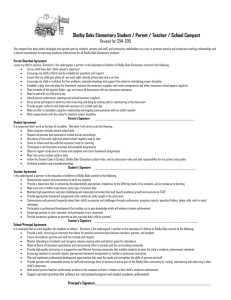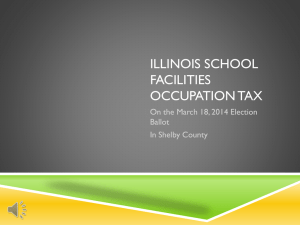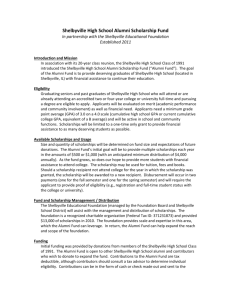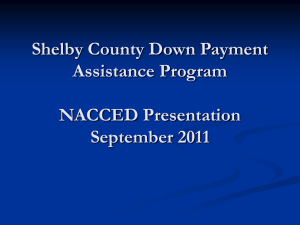007 - CHAPTER IV - WATER AND SEWAGE DISPOSAL
advertisement
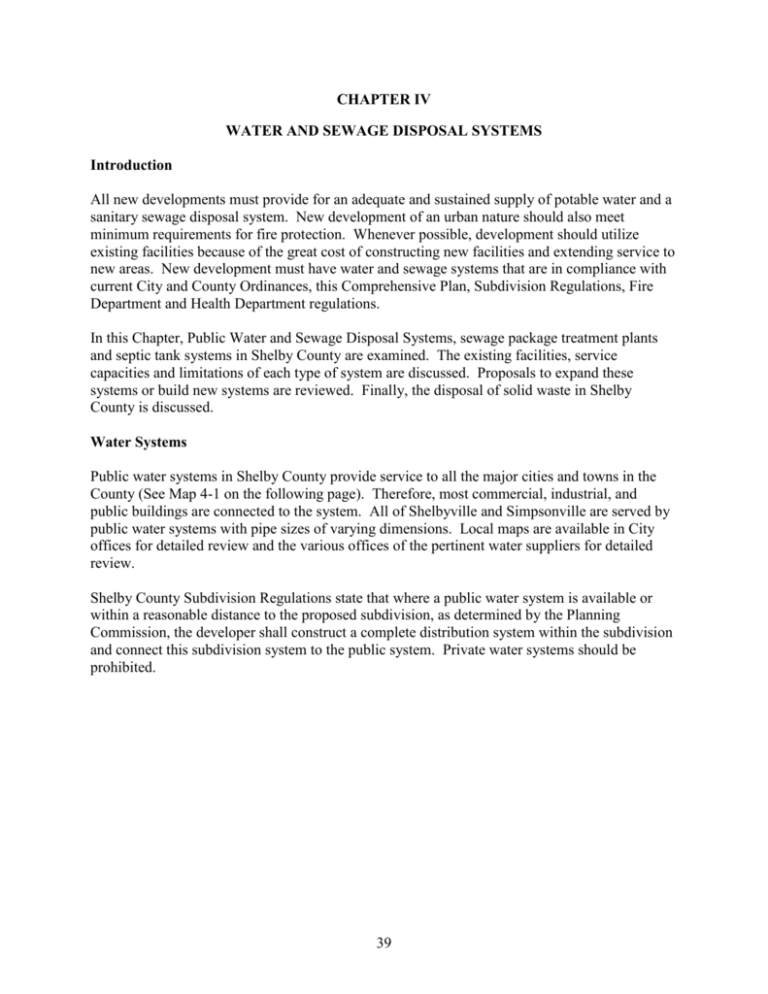
CHAPTER IV WATER AND SEWAGE DISPOSAL SYSTEMS Introduction All new developments must provide for an adequate and sustained supply of potable water and a sanitary sewage disposal system. New development of an urban nature should also meet minimum requirements for fire protection. Whenever possible, development should utilize existing facilities because of the great cost of constructing new facilities and extending service to new areas. New development must have water and sewage systems that are in compliance with current City and County Ordinances, this Comprehensive Plan, Subdivision Regulations, Fire Department and Health Department regulations. In this Chapter, Public Water and Sewage Disposal Systems, sewage package treatment plants and septic tank systems in Shelby County are examined. The existing facilities, service capacities and limitations of each type of system are discussed. Proposals to expand these systems or build new systems are reviewed. Finally, the disposal of solid waste in Shelby County is discussed. Water Systems Public water systems in Shelby County provide service to all the major cities and towns in the County (See Map 4-1 on the following page). Therefore, most commercial, industrial, and public buildings are connected to the system. All of Shelbyville and Simpsonville are served by public water systems with pipe sizes of varying dimensions. Local maps are available in City offices for detailed review and the various offices of the pertinent water suppliers for detailed review. Shelby County Subdivision Regulations state that where a public water system is available or within a reasonable distance to the proposed subdivision, as determined by the Planning Commission, the developer shall construct a complete distribution system within the subdivision and connect this subdivision system to the public system. Private water systems should be prohibited. 39 40 Public Water System Shelby County is served by six water districts: the Shelbyville Municipal Water System, North Shelby Water Company, West Shelby Water District, Henry County Water District No. 2, US 60 East Water District and Taylorsville Water System. The Shelbyville Municipal Water System serves about 6,500 customers (a population of approximately 21,000) in the Shelbyville area and along KY 55 and KY 53 south of Shelbyville and I-64. The West Shelby Water District serves about 1,400 total customers in the southwest portion of Shelby County and a small portion of Jefferson County between KY 55 south to the Jefferson County line. West Shelby Water District is provided water by both Shelbyville Municipal Water system and the Louisville Water Company. The North Shelby Water Company serves about 4,017 total customers in north Shelby County and small portions of Jefferson, Oldham, Henry and Franklin Counties. North Shelby is provided water by the Shelbyville, Frankfort and the Louisville Water Systems. All water provided by the Shelbyville Water System is supplied by Guist Creek Lake reservoir, and treated at the water filtration plant which was last expanded in 1999. The current capacity of the plant is 6.0 million gallons per day. Peak daily usage for the year 2001 was 5.04 million gallon per day, with the peak month at 3.58 million gallons/day, and the average daily treatment for 2001 was 3.3 million gallons per day. The US 60 East Water District serves about 1,765 customers in the Waddy area and along US 60 East. Water is supplied to this District by the Frankfort Water System. The Frankfort Water treatment Plant is designed to produce 18 million gallons per day and their average in 1995 was 9.7 million gallons per day. Some modifications were being done in 1996. The Taylorsville Water System serves about 309 total customers in Southeast Shelby County in and near the Mt. Eden community. Each water meter in the system is considered a customer. Sewage Disposal System Shelbyville, Simpsonville and their peripheries are the only areas in Shelby County served by public sewage collection systems. In order for economic planning related to the future expansion as well as debt retirement of these public systems, it is necessary that policies and ordinances be established to ensure the adequacy of the infrastructure for these systems to sustain growth within the planning area. The establishment of subdivisions within the Urban Service Area of Shelbyville and Simpsonville that are not connected to a government wastewater treatment and collection system and that are on tracts of less than five (5) acres in size shall be prohibited except for minor subdivision in the Agricultural Zone district, which are not located with in the Guist Creek Lake watershed, Shelbyville 201 Planning Area, nor the Lake Shelby 201 Plan Conservancy Area. Within the Guist Creek Lake watershed all lots shall be a minimum no less than 5 acres. Guist Creek Lake is an environmentally sensitive area, and the source of drinking water for the majority of Shelby County residents. Neither privately owned nor publicly owned wastewater 41 collection/treatment systems shall be installed in the Guist Creek watershed. Any development in this watershed shall be very low density (minimum 5 acres tracts) and provisions shall be made for erosion and sediment control for any construction in this watershed. The use of “Best Management Practices for Construction Activities” shall be required in accordance with the Division of Water NRPEC, U.S. Natural Resources Conservation Service. Pesticides and Herbicides for residential use shall not be allowed within the Guist Creek Lake Watershed, with the exception that termite treatment for residential homes shall be allowed with application only by a licensed and bonded firm for this specialty. The establishment of subdivisions that are not connected to publicly owned systems, but are within the 201 Planning Area of the Shelbyville Municipal Water and Sewer Commission shall not be permitted, irregardless of lot sizes. This is necessary for the continuity of the collection system infrastructure, and shall be considered premature for development. For any proposed development within the 201 Planning Area, a signature of the authorized representative of the Shelbyville Municipal Water and Sewer Commission shall be required to be on the preliminary and final plat, or PUD, confirming that the property is not within the 201 Planning Area, if the property is not proposed to be served by a publicly owned wastewater system. A zoning ordinance provision has been adopted for minor subdivisions that addresses specific circumstances or provisions wherein this prohibition shall not apply. Development on septic systems shall abide by the ordinances that require connection to a governmental wastewater treatment and collection system as such becomes available. Residential zoning should not be granted in areas outside the growth areas of the rural villages and the Urban Service Area and/or the 201 Planning Areas of Shelbyville and Simpsonville and the rural village growth areas should meet the development provisions of the Agricultural zone. Most commercial, industrial and public buildings in the Shelbyville area are connected to the wastewater collection system. In March 2000 the Sanitation District #1 of Shelby County was consolidated into the Shelbyville Municipal Water and Sewer Commission. Existing Shelby County Subdivision Regulations state that, were a public sanitary sewer system is available or reasonably accessible to the proposed subdivision, as determined by the Planning Commission, the Developer will construct a collection system within the subdivision and connect this subdivision system to the public system. Where a public sanitary system is not accessible, each builder will develop individual subsurface disposal on each lot (usually a septic tank system). It is the policy of this Plan to discourage the establishment of private residential sewage treatment plants and none shall be approved until the conditions under which private treatment plants can be established or developed and specified in Zoning and Subdivision Regulations. Septic tank systems can be installed only on single parcels of land that are at least two (2) acres 42 in size, but not within the 29.5 square miles of Guist Creek Lake watershed. Before such a lot is developed, the soil must pass a soil evaluation test to measure its suitability for the septic tank system. These regulations were adopted because most soils in Shelby County are not suitable for septic tank systems. Public Sewage Disposal System The Shelbyville Sewer Commission serves principally within and around the city limits of Shelbyville as well as the major industrial area off Ky. 55 between U. S. 60 and I-64 and the Shelbyville Municipal Wastewater Treatment Plant provides treatment. Recently sewer systems have been made available within certain portions of the Urban Service Areas south of I-64, on both Hwy. 55 South and Hwy. 53 South. The treatment plant was expanded in 1992 and currently has capacity of 1.87 million gallons per day. Average daily treatment in 2001 was 1.583 million gallons per day, or 85% of treatment capacity. Design for the next expansion will begin when the plant reaches 90% of capacity. The Shelbyville Sewer Commission’s 201 Facilities Plan is currently being updated. The plant has consistently met all NPDES permit requirements, including chronic toxicity testing. In late 1981, a sewage treatment system was constructed in Simpsonville. The system is designed primarily to serve areas within the city that has already been developed. The capacity of the sewage disposal plant is 205,000 gallons per day and is pumping 156,000 gallons per day. Simpsonville is presently planning expansion of the treatment facility to 500,000 gallons per day with provisions to expand to 1,000,000 per day if needed to serve development in the city and its service area. This expansion will be accomplished by changing from a lagoon system to a mechanical system. Sewage Package Treatment Plants A sewage package treatment plant is a relatively small treatment facility providing secondary or tertiary wastewater treatment for specific site. They generally serve sites where public sewage disposal systems are inaccessible and where septic tank systems are not adequate to treat the waste produced by the site. In 1980, there were about 30 sewage package treatment plants in Shelby County, with design capacities ranging from 1,000 to 4,000 gallons per day. They served a variety of sites: residential, commercial, industrial, public, semi-public, parks and recreation. In 1990 there were only two (2) residential package treatment plants and 15 systems serving other land uses. In the last 10 years, 15 private sewage treatment plants have been incorporated into municipal facilities. Residential package treatment plants are prohibited in Shelby County. Septic Tank Systems A septic tank is an onsite sewage treatment system consisting of two parts; the septic tank, where sewage is retained and digested by organic matter, and the drain field where the resulting effluent is distributed into the ground. Septic tanks are utilized by residential lots and farmhouses outside 43 the Urban Service Area where public sewers are not available. Existing soils, rocks, trees or topographic conditions as well as an adequate replacement area for the system necessitate tracts larger than one (1) acre in size for septic tanks. With all conditions favorably met, the minimum lot size is two (2) acres for such installation excluding areas within the Guist Creek Lake watershed and Residential Estates. Major subdivisions utilizing septic tanks on lots less than five (5) acres in size are mot permitted around the cities of Simpsonville and Shelbyville or the Guist Creek Lake watershed nor the Lake Shelby 201 Plan Conservancy area. In the late 1980’s Shelby County and the EPA, through Sanitation District #1 spent in excess of $6 million to install sewer collection systems to existing properties being served principally by septic tanks, and others by package treatment plants. The City and County are presently spending in excess of $1.3 million to abandon septic systems in Meadowbrook Subdivision. These large amounts of public expenditures were a result of failed/failing septic tanks and poor soil conditions. Regulations now limit the use of septic tank systems to lots of at least two (2) acres in size, unless zoned Residential Estates that allows for one (1) acre tracts, unless within the Guist Creek Lake watershed, which requires a minimum of five (5) acres. It is important to note that these are alternative types of on-site waste treatment that may be allowed by the local health Department and by the Commonwealth. A builder should consult with the Health Department and State prior to planning traditional on-site treatment systems. However, the minimum lot sizes as described previously for septic tanks shall apply to alternative on-site treatment systems. Disposal of Animal Waste Shelby County has a large inventory of livestock, including dairy farms and horse farms, which generate a large volume of animal waste. The disposal of this waste has been a problem in the County. The problem is most acute where the livestock are confined in barns or small areas, where the waste is accumulated. Several farms have built lagoons for the disposal of this waste. In some cases, the animal waste is dispersed from the lagoon into surrounding fields. The U. S. Soil Conservation Service and the Agricultural Stabilization Conservation Service are assisting farmers on an individual basis in dealing with this disposal. Solid Waste Disposal There is only one county-owned convenience center for the disposal of solid waste in Shelby County. The City of Shelbyville landfill that was located on Kentucky Street near the Shelbyville Sewage Treatment Plant has been closed for several years. The Shelby County Convenience Center is located on Kings Highway, Hwy. 637, about 1.7 miles east of Waddy. A recycling center has been established at 86 Seventh Street in Shelbyville. However, considering the projected growth of Shelby County, additional capacity may soon be needed. Shelby County has prepared and follows a solid waste management plan as required by State Law. The need for additional capacity is being address by the Shelby County 109 Board, 44 and the necessity of regional facilities is being considered. Privately owned/operated solid waste facilities are prohibited in Shelby County. Summary The public water system in Shelby County provides service to all major cities and village areas in the County. Therefore, most commercial, industrial, and public buildings are connected to the systems. However, there are still some rural residences that have other means of water supply. The Subdivision Regulations state that where a public system is available to a proposed subdivision, the developer shall connect that subdivision to the system. The City of Shelbyville and its environs enjoys a Class 3 Fire Protection rating. Subdivisions with minimal side setbacks shall install water lines and fire hydrants sized for the increased fire flow requirements. The capacity of the Shelbyville Municipal Water Treatment Plant at Guist Creek Lake, which serves three of the County’s six (6) water suppliers, was expanded in 2000 from 4.6 million gallons per day to 6.0 million gallons per day. Average daily treatment in 2000 was 3.16 million gallons per day. The other water suppliers in Shelby County have done an excellent job in planning by designing/improving their systems, placing more reliance on the Louisville and Frankfort Water Companies. This has effectively reduced the demand of the Shelbyville Water System, with more interconnections between suppliers that will improve the ability to deal with emergency situations, as well as to keep up with projected growth in this area. Shelbyville and Simpsonville are the only cities now served by public disposal systems. Sewer Interceptor/Collection lines surrounding Shelbyville, and the industrial areas on either side of KY 55 between US 60 and I-64. Sewers are also now available for certain areas south of I-64 on both KY 53 and KY 55, within the Urban Service Area. The Subdivision Regulations, as well as City and County Ordinances state that, where a public sewer system is available to a proposed subdivision, the developer shall connect that subdivision to the public sewer system. The Health Department and other County ordinances restrict septic tanks to lots at least two (2) acres in size, except for one (1) acre lots in Residential Estates development, provided the soil passes an evaluation. The regulation is necessary because the soils in Shelby County are not generally suitable for septic use. However, subdivisions within the Guist Creek Lake watershed shall be limited to a minimum of five (5) acres, as the lake is a vital natural resource and major source of water supply for Shelbyville and a large part of Shelby County. Subdivisions within the Lake Shelby 201 Plan Conservancy area shall also be limited to a minimum of five (5) acres as well. 45 The disposal of animal waste is a concern in Shelby County because of the large inventory of livestock. The U. S. Soil Conversation Service and the Agricultural Stabilization Conservation Service assists farmers in dealing with this problem. The Shelby County Convenience Center has been sufficient, but in the near future additional capacity will need addressing in the solid waste management plan. Recommendations It is recommended that public water systems be expanded to serve all residents in the County when it is feasible to extend such services. It is also recommended that public sewer facilities be extended to the boundaries of the Urban Service Areas when feasible. Subdivisions inside the proposed Urban Service Areas of Shelbyville and Simpsonville should be served by the appropriate government and its water, sewer, street maintenance, streetlights and signage, police and fire protection of the appropriate governmental agency. Development proposals in the Urban Service Areas should have full review and general acceptance of all appropriate government agencies prior to their approval by the Planning Commission. In the rural communities, developments in the proposed growth area of villages should have at least the same level of service that exists for inhabitants or establishments in that particular community. The recommendations and considerations herein also apply to the Land Use and implementation sections of the Plan and should be taken into consideration in the development of the Subdivision Regulations and other pertinent review processes. 46

